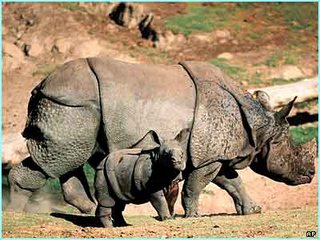All about Indian Rhinocerous
A few centuries ago, the Indian one horned Rhinocerous ranged across the north Indian plains in the wetlands of the rivers Indus, Ganga, and Brahmaputra. Today this survivor from the prehistoric times is found only in pockets in the north eastern state of Assam and in Nepal. In Assam, their Rhino habitat is limited to just two national parks - Kaziranga and Manas.
 Type of Rhinos
Type of RhinosThere are five kinds of Rhinos found in the world - white rhino, black rhino, Indian rhino, Javan rhino, and Sumatran rhino. The white and black Rhinos are live in Africa, while Indian, Javan and Sumatran are Asian Rhinos, found in Noth Pakistan, Assam in India, Nepal, Bhutan and Bangladesh.
The usual weight of an Indian Rhino is 2,000 kg. The one way to distinguish between a an Indian Rhino and an African Rhino is the single horn. Both white and black African Rhinos have two horns. Another distinguishing feature of the Indian Rhinoceros is its skin, which is knobbly and falls into deep folds at its joints, giving a look like the Rhino is wearing a coat of armour.
All the Rhinos are vegetarian and Indian Rhinos mostly eat grass, fruits, leaves and crops. Their well developed upper lip helps them to eat out tall elephant grasses, which they like the best. It also helps them to pull out aquatic plants by the roots. Indian Rhinos usually prefer to roam around in the morning and evening hours to avoid the heat of the day and live for about 40 years.
Kaziranga National Park
Lying along the mighty Brahmaputra river, the Kaziranaga National Park covers an area of about 430-sq-kms. Its swamps and grasslands with tall thickets of elephant grass and patches of ever green forest support the largest number of Rhino population in the whole of Indian subcontinent. Once reached to an alarming point due to hunting and poaching, this area came under wildlife conservation in 1926 and in 1940, Kaziranga was declared a sanctuary.
Wild Attractions of Kaziranga - Indian Rhino
The open county makes wildlife viewing at Kairanga fairly easy. A day's outing is often sufficient for visitors to see most of the major species here. Elephants take them into the park at the early morning hours. Other wildlife attractions at Kaziranga include Barasingha, Wild Buffalo, Wild elephants and Wild Boars. The grassland area is a raptor country and the crested Serpant Eagle and the Pallas Fishing Eagle and the grey-headed fishing Eagle can be seen circling over the marshes. The water-bird variety includes Swamp Parridges, Bar-headed Geese, Whistling Teal, the Bengal Florican, Storks, Herons and even Pelicans.
Manas National Park
Manas national park is another Rhino refuge and is noted for its population of the rare Golden Langur - found only this part of India. Other primates in Manas include the Capped Langur, Assamese Macaque, the slow Loris and the Hoolock Gibbon. Over 2, 840-sq-kms in area, Manas is a fascinating Tiger Reserve. The reserve is also home to the attractive Red Panda, but these are seen occasionally in the higher elevations. Manas is a very special biosphere, for it harbours twenty species of birds and animals that are highly endangered and listed in the IUCN Red Data Book. These include the Hispid Hare and the Pigmy Hog.
posted by Rishil Babu @ 1:14 PM,
![]()